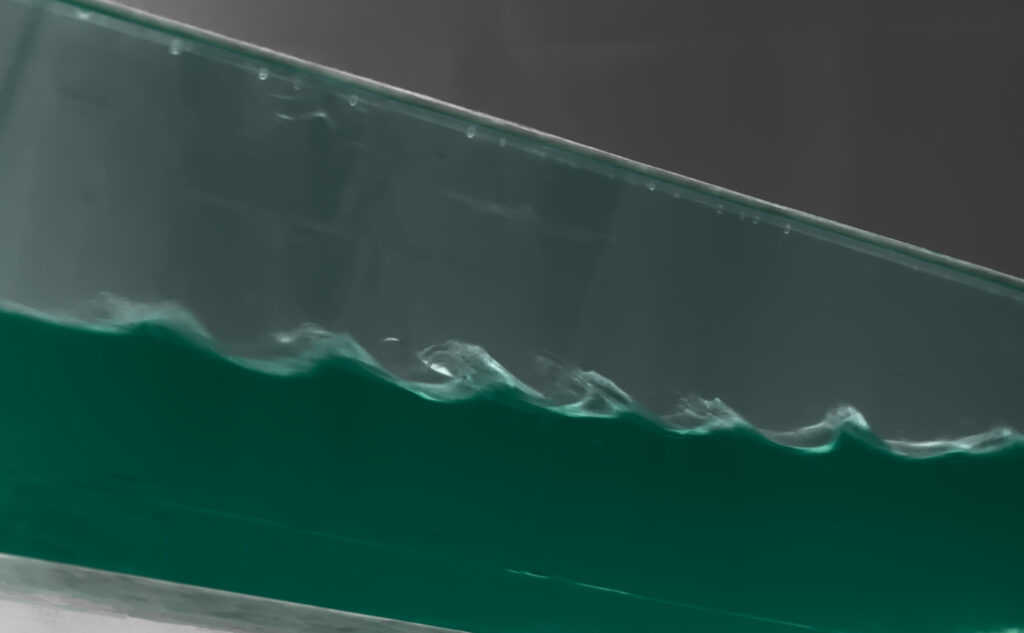This image shows the Kelvin-Helmholtz instability: an instability that forms at the interface of fluids moving at different velocities. The lower fluid is canola oil, and the upper fluid is 90% isopropyl alcohol, two fluids that are immiscible and hold separate dye colors well. The height of this tank is 4.5″. These waves were formed by initially resting the tank on a level surface until the fluids were still and well separated. Then the tank was tilted, which creates a velocity gradient as the heavier oil tries to slide beneath the lighter alcohol. As the fluids move in opposite directions, Kelvin-Helmholtz waves form.
This image was recolored to highlight the waves.
Report


16 Comments. Leave new
Interesting phenomenon and hard to capture – good job! My only comment may be that it’s a little bit blurry, but that is understandable given the circumstances.
Capturing a phenomenon in motion is a challenging task. Great job!
I like your take on this form! Tilting it made it look more unique. Why did you decide to choose the colors for each liquid with the edited picture?
Hi Jessica,
I wanted the bottom fluid to be darker, and I chose the lighter fluid to be a lighter color to highlight the contrast between them, but I am open to other color suggestions.
I also just didn’t like the canola oil yellow in the original :)
You said that you couldn’t get the proper effect if the angle wasn’t steep enough. Did you play with using momentum (picking it up and then putting it down multiple times) at shallower angles to possibly get the same effect on a level surface?
Hi Will,
Picking it up and setting it down multiple times creates a lot of disorder in the fluids as bubbles form in the interface layer. Shallower angles would work if I had a longer tank, which gives the fluids more time to move against each other and build up momentum. A longer tank also increases the length of the region of the flow that breaks into Kelvin-Helmholtz waves.
First I will say this is an awesome experiment. I attempted to do something similar to this however, I couldn’t get my hands on a container like yours. I have a question about when the best “waves” were generated. When you tilted the container, did you catch the best photos on the initial lift or some sort of wave interference following the initial lift?
Hi Peter,
I found the best waves were created a couple of seconds after I lifted the tank. The fluids started still and well-separated, but after the initial interaction, a lot of bubbles form between the two fluids, causing any later photos to be unclear. There is another set of waves when I set the tank back down, and the fluids move back.
I like the way the alcohol doesn’t look like a liquid, it almost looks like air, it really highlights the waves of the oil. I think this photo falls into the beauty aesthetic, although waves can be destructive, these small ones come off as serene. I am interested in how a different background color would affect how the waves pop.
Why did you choose the colors you did while editing the photo?
Hi Travis,
See my response to Jessica’s question, above.
I would be interested to hear about how the angle of the tank impacts the waves, and how the angle of the fluid interface compares to the angle of the tank. (What angle is the fluid interface compared to the angle of the tank or compared to horizontal? Why?/How does that work?)
Hi Kate,
I noticed that the angle of the tank had a pretty strong effect on the quality of the waves I was able to generate, but didn’t conduct this experiment in a controlled enough manner to make any quantitative statements on that. An angle too shallow didn’t generate any waves, and an angle too steep resulted in motions too chaotic to see any organized waves. At some shallow angles, I did observe some waves that never broke, but that wasn’t the picture I was going for.
The angle of the fluid interface is something that constantly changes with time. At the beginning of the experiment, when the tank is level, the angle between the fluid interface and the tank is 0°. As I tilt the tank to some angle θ, the angle of the fluid interface is (briefly) still 0°, but as the fluids move to opposite ends of the tank, they will eventually reach angle θ with the now-tilted tank. So compared to the tank, the angle of the fluid interface changes from 0° to θ throughout the experiment. The Kelvin-Helmholtz waves appear somewhere in the middle of the experiment. Since the Kelvin-Helmholtz waves are the result of an instability caused by some perturbation to the fluid interface, I would guess that they don’t appear at a perfectly consistent angle. However, there is probably some range of angles where they’re likely to appear.
Great job with the color corrections and describing the flow in an intuitive way. You had great timing capturing this wave behavior.
I am curious how you picked your zoom setting (the initial setup) and also your cropping after the fact. Did you try a closer up image? If you would like, I have some opinions to share on this topic.
Hi Sam,
The zoom setting was chosen to capture the entire region where I noticed the waves were most likely to appear since they didn’t appear in a consistent location within the tank. I cropped out the black table the tank was resting on, but even if the table hadn’t been there, I probably would have cropped it here. I wanted the photo to show the repeating waves (4-5+).
Feel free to share any opinions.